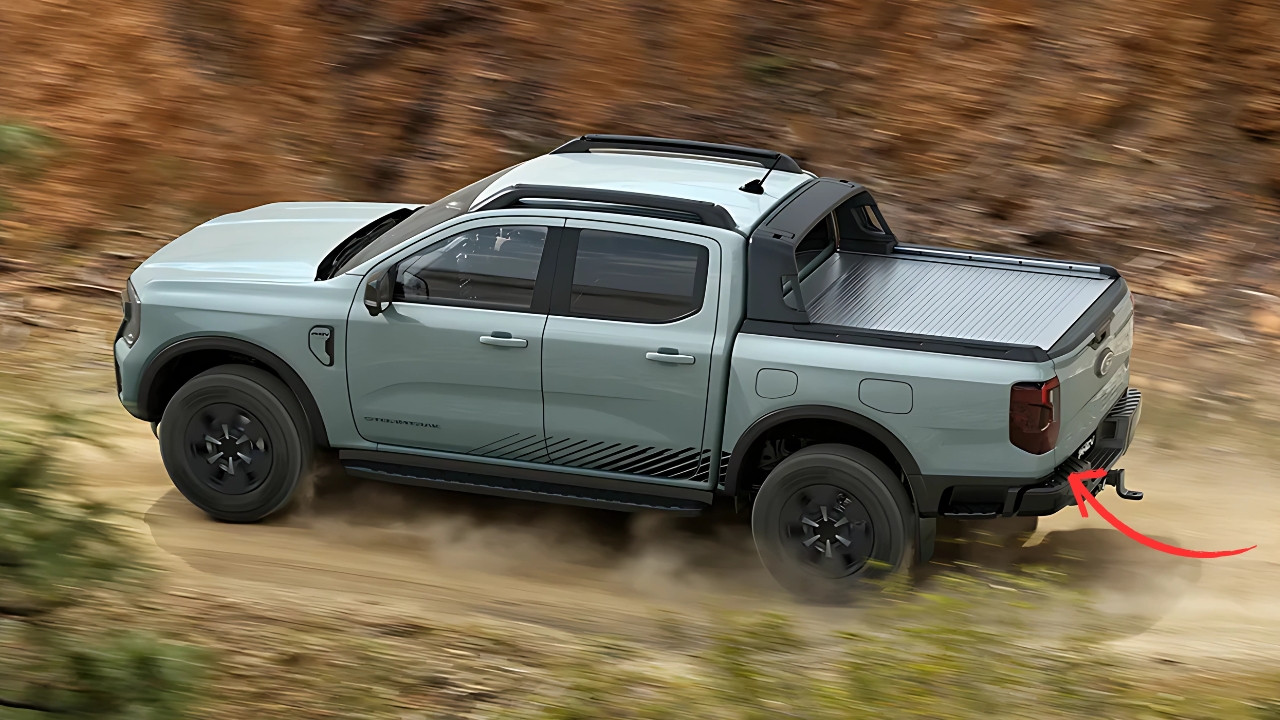Ford Ranger PHEV: The automotive landscape is experiencing a seismic shift toward electrification, and Ford’s latest innovation, the Ranger PHEV, represents a masterful blend of traditional truck capability with cutting-edge hybrid technology.
The new Ford Ranger Plug-in Hybrid (PHEV) delivers all the no-job-too-big capability of Europe’s best-selling pickup – for the first time boosted by an advanced hybrid powertrain that can put electric power to use on the road or the worksite.
What makes this pickup truly fascinating is the sophisticated EcoBoost power adjustment system that optimizes performance, efficiency, and capability in ways previously impossible.
Understanding the EcoBoost Power Adjustment Strategy
The Engineering Philosophy Behind Detuning
Ford was willing to sacrifice performance for efficiency in developing its first Ranger plug-in hybrid (PHEV) ute, which features a heavily detuned version of the turbo-petrol four-cylinder engine found in the Ford Mustang EcoBoost. This decision wasn’t made lightly. Ford’s senior global product executive, Jim Baumbick, explains the rationale: “Could you add more performance? Yes. Would it come with tradeoffs? You bet – fuel economy. One of the critical attributes of a hybrid is total cost of ownership and fuel-efficiency.”
The 2.3-liter EcoBoost engine in the Ranger PHEV produces significantly different power figures compared to its applications in other Ford vehicles. While outputs tally 232kW/475Nm and 222kW/452Nm for the Mustang and Amarok, respectively, the Ranger PHEV makes do with just 138kW and 411Nm, albeit supplemented by electric power. This strategic detuning serves multiple purposes: improved fuel economy, reduced emissions, and enhanced system integration with the electric motor.
Advanced Hybrid Powertrain Integration
The heart of the Ranger PHEV lies in its sophisticated powertrain combination. Ranger PHEV’s all-new plug-in hybrid powertrain combines Ford’s 2.3-litre Ford EcoBoost petrol engine and 10‑speed automatic gearbox with a 75 kW electric motor (e-motor) and an 11.8 kWh (useable) lithium-ion traction battery. The system produces impressive combined outputs: Up to 697 Nm of torque from the combined e-motor and EcoBoost petrol engine is the highest of any production Ranger ever – and peak power of 281 PS is more than a Ranger 3.0-litre V6 turbodiesel.
Power Mode Selection and Adjustment Systems
Comprehensive Drive Mode Portfolio
The Ranger PHEV features an extensive array of drive modes that showcase the versatility of its EcoBoost power adjustment system. Drivers can choose between Normal, Eco, Sport, Slippery, Tow/Haul, Mud/Ruts and Sand modes, and Ranger PHEV will adjust the torque distribution to the wheels for the best performance. Each mode fundamentally alters how the EcoBoost engine and electric motor work together, creating distinct driving personalities for different scenarios.
The system’s intelligence extends beyond simple mode selection. Ranger PHEV’s e-4WD system can automatically send petrol, electric or hybrid torque to all four wheels to help tackle challenging terrain or suit specific driving scenarios – supported by a dual-range transfer box and rear differential lock.
Electric Vehicle Operation Modes
The power adjustment system includes sophisticated battery management options. On the move, drivers can choose when and how to use battery power with Auto EV, EV Now, EV Later or EV Charge modes. These modes allow precise control over energy deployment, whether prioritizing electric-only operation for urban environments or conserving battery power for specific scenarios.
The EV Charge mode deserves special attention, as it demonstrates the system’s flexibility. There is an ‘EV Charge’ mode to top the battery back up while on the move using the engine’s power – which supposedly takes around two hours. The downside is it will cause fuel consumption to skyrocket. This feature proves invaluable when approaching low-emission zones or when electric operation becomes necessary.
Technical Specifications and Performance Metrics
Powertrain Configuration Details
The Ranger PHEV’s technical specifications reveal the sophisticated engineering behind its power adjustment capabilities. The battery takes less than four hours to charge using a single-phase 16 amp charger, and with a full charge, Ranger PHEV is capable of up to 43 km pure-electric driving – more than the daily driving distance of 52 per cent of Ranger customers according to Ford research.
| Specification | Value |
|---|---|
| Engine Type | 2.3L EcoBoost Turbocharged I4 |
| Electric Motor Power | 75 kW |
| Battery Capacity (Usable) | 11.8 kWh |
| Combined System Power | 207 kW (281 PS) |
| Combined System Torque | 697 Nm |
| Electric Range | 43-49 km |
| Towing Capacity | 3,500 kg |
| Payload Capacity | Up to 973 kg |
| Fuel Consumption (Combined) | 2.9L/100km |
| CO2 Emissions | 66 g/km |
| Charging Time (16A) | Less than 4 hours |
Pro Power Onboard Integration
One of the most innovative aspects of the EcoBoost power adjustment system is the integration of Pro Power Onboard technology. Ranger PHEV is the first Ranger to offer Ford’s Pro Power Onboard technology, meaning customers who work hard and play hard can leave their generators at home and power high-draw tools and equipment using the traction battery. Customers can specify a 2.3 kW system that’s ideal for powering weekend trips to the trails with the capacity to comfortably charge multiple e-mountain bikes (650 W) and a portable fridge (65 W).
Manufacturing Excellence and Global Reach
South African Production Hub
Launching in Europe, Australia, and New Zealand in 2025, the South African-made Ranger PHEV combines a 2.3L EcoBoost engine with a 75kW electric motor and 11.8kWh battery. It maintains the Ranger’s 3,500kg towing capacity and introduces Pro Power Onboard. Ford’s Silverton Manufacturing Plant has undergone extensive upgrades to support PHEV production, including the construction of a dedicated Battery Assembly Plant featuring advanced testing and quality control systems.
Sustainability Initiatives
The manufacturing process reflects Ford’s commitment to environmental responsibility. All such initiatives are complemented by the Silverton Manufacturing Plant’s pioneering solar carpark, which uses more than 30,000 solar panels to generate 13.4MW of electricity – sufficient to power the entire Plant during the day.
Competitive Landscape and Market Position
Efficiency Comparisons
While the Ranger PHEV represents a significant step forward for Ford, the competitive landscape presents challenges. Ford claims average fuel consumption of 2.9L/100km for the Ranger PHEV, while carbon emissions tally 66g/km. In isolation, plug-in hybrid versions of the Ranger are an eco-friendly option in the mid-size ute market. However, key Chinese rivals have the Ranger beat in terms of efficiency – the BYD Shark 6 and GWM Cannon Alpha PHEV consume a claimed 2L/100km and 1.7L/100km, respectively.
Strategic Importance for Emissions Compliance
The Ranger PHEV will serve as a key pillar of Ford’s initial response to the New Vehicle Emissions Standard (NVES) in Australia, with sales of the greener ute set to help offset fines accrued by other models in the lineup. This strategic positioning demonstrates how the EcoBoost power adjustment system serves broader corporate objectives beyond individual vehicle performance.
Future Implications and Development
The Ford Ranger PHEV’s EcoBoost power adjustment system represents more than just a technological achievement—it’s a blueprint for the future of commercial vehicles. The sophisticated integration of combustion and electric power, combined with intelligent mode selection and real-time power distribution, creates a platform that can adapt to diverse customer needs while meeting increasingly stringent environmental regulations.
The system’s success lies not in maximizing any single attribute, but in creating optimal balance across multiple priorities: capability, efficiency, performance, and environmental responsibility. As electrification continues to reshape the automotive industry, the Ranger PHEV’s approach to power adjustment offers valuable insights into how traditional truck capabilities can coexist with modern sustainability requirements.
Frequently Asked Questions
Q: Why did Ford detune the EcoBoost engine in the Ranger PHEV? A: Ford prioritized fuel efficiency and total cost of ownership over maximum power output. The detuned engine works optimally with the electric motor to achieve 2.9L/100km fuel consumption and 66g/km CO2 emissions.
Q: What is the electric-only range of the Ranger PHEV? A: The Ranger PHEV offers up to 43-49km of pure electric driving, which covers the daily driving needs of more than half of Ranger customers according to Ford research.
Q: How long does it take to charge the Ranger PHEV? A: Using a single-phase 16 amp charger, the battery can be fully charged in less than four hours. The system also supports charging while driving through the EV Charge mode.
Q: Does the PHEV maintain the same towing capacity as diesel Rangers? A: Yes, the Ranger PHEV maintains the full 3,500kg towing capacity while adding the benefits of electric torque assistance and improved fuel efficiency.

